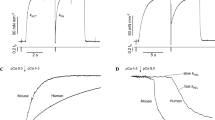Abstract
We describe a model of mitochondrial regulation in vivo which takes account of spatial diffusion of high-energy (ATP and phosphocreatine) and low-energy metabolites (ADP and creatine), their interconversion by creatine kinase (which is not assumed to be at equilibrium), and possible functional 'coupling' between the components of creatine kinase associated with the mitochondrial adenine nucleotide translocase and the myofibrillar ATPase. At high creatine kinase activity, the degree of functional coupling at either the mitochondrial or ATPase end has little effect on relationships between oxidative ATP synthesis rate and spatially-averaged metabolite concentrations. However, lowering the creatine kinase activity raises the mean steady state ADP and creatine concentrations, to a degree which depends on the degree of coupling. At high creatine kinase activity, the fraction of flow carried by ATP is small. Lowering the creatine kinase activity raises this fraction, especially when there is little functional coupling. All metabolites show small spatial gradients, more so at low cytosolic creatine kinase activity, and unless there is near-complete coupling, so does net creatine kinase flux. During workjump transitions, spatial-average responses exhibit near-exponential kinetics as expected, while concentration changes start at the ATPase end and propagate towards the mitochondrion, damped in time and space. (Mol Cell Biochem 174: 29–32, 1997)
Similar content being viewed by others
References
Kushmerick MJ, Meyer RA, Brown TR: Regulation of oxygen consumption in fast-and slow-twitch muscle. Am J Physiol 263: C598– C605, 1992
Funk C, Clark A, Connett R: A simple model of aerobic metabolism: applications to work transitions in muscle. Am J Physiol 258: C995– C1005, 1990
Kemp GJ: Interactions of mitochondrial ATP synthesis and the creatine kinase equilibrium in skeletal muscle. J Theor Biol 170: 239–246, 1994
Meyer RA: A linear model of muscle respiration explains mono-exponential phosphocreatine changes. Am J Physiol 254: C548–C553, 1988
Fedosov SN: Creatine-creatine phosphate shuttle modeled as two-compartment system at different levels of creatine kinase activity. Biochim Biophys Acta 1208: 238–246, 1994
McFarland EW, Kushmerick MJ, Moerland TS: Activity of creatine kinase in a contracting mammalian muscle of uniform fibre type. Biophys J 67: 1912– 1924, 1994
Saks VA, Khuchua ZA, Vasilyeva EV, YuBelikova O, Kuznetsov AV: Metabolic compartmentation and substrate channelling in muscle cells. Mol Cell Biochem 133/134: 155–192, 1994
Saks VA, Lipina NV, Smirnov VN: Studies of energy transport in heart cells. The functional coupling between mitochondrial creatine phosphokinase and ATP-ADP translocase: kinetic evidence. Arch Biochem Biophys 173: 34–41, 1976
Aliev MK, Saks VA: Quantitative analysis of the 'phosphocreatine shuttle': I. A probability approach to the description of phosphocreatine production in the coupled creatine kinase-ATP/ADP translocaseoxidative phosphorylation reactions in heart mitochondria. Biochim Biophys Acta 1143: 291–300, 1993
Saks VA, Vasil'eva E, Belikova YO, Kuznetsov AV, Lyapina S, Petrova L, Perov NA: Retarded diffusion of ADP in cardiomyocytes: possible role of mitochondrial outer membrane and creatine kinase in cellular regulation of oxidative phosphorylation. Biochim Biophys Acta 1144: 134–148, 1993
Gellerich FN, Kapischke M, Kunz W, Neumann W, Kuznetsov A, Brdiczka D, Nicolay K: The influence of the cytosolic oncotic pressure on the permeability of the mitochondrial outer membrane for ADP: implications for the kinetic properties of mitochondrial creatine kinase and for ADP channelling into the intermembrane space. Mol Cell Biochem 133/134: 85–104, 1994
Meyer RA, Sweeney HL, Kushmerick MJ: A simple analysis of the 'phosphocreatine shuttle'. Am J Physiol 246: C365–C377, 1984
Veksler VI, Kuznetsov AV, Anflous K, Mateo P, vanDeursen J, Wieringa B, Ventura-Clapier R: Muscle creatine kinase-deficient mice. II. Cardiac and skeletal muscles exhibit tissue-specific adaptation of the mitochondrial function. J Biol Chem 270: 19921–19929, 1995
Hamman BL, Bittl JA, Jacobus WE, Allen PD, Spencer RS, Tian R, Ingwall JS: Inhibition of the creatine kinase reaction decreases the contractile reserve of isolated rat hearts. Am J Physiol 269: H1030– H1036, 1995
Author information
Authors and Affiliations
Rights and permissions
About this article
Cite this article
Kemp, G., Manners, D., Clark, J. et al. A theoretical model of some spatial and temporal aspects of the mitochondrion creatine kinase myofibril system in muscle. Mol Cell Biochem 174, 29–32 (1997). https://doi.org/10.1023/A:1006895521017
Issue Date:
DOI: https://doi.org/10.1023/A:1006895521017




